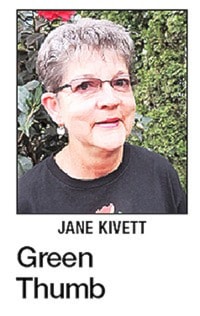This is the time of year when the days get longer and the sun is higher that gardeners start to get excited.
You say you are not a gardener? All of mankind has custody of the environmental garden.
It is a big responsibility indeed, but we can start with our surrounding area.
Carry a bag when out walking or hiking and pick up garbage.
A clean landscape appeals to most everyone.
Garbage in the waterways is hard to retrieve, but an attempt should be made.
Dumping green waste and grass clippings in the bush makes for an unpleasant sight and odour and should be reported, especially if the “dumper” is known.
Throwing spent hanging baskets in the bush has resulted in English ivy and lamium to run wild. Where they go, nothing grows!
When ivy plants climb trees they compete for water, nutrients and sunlight causing a weaker tree, therefore more prone to disease and branch dieback.
The added moisture around the bark as the vine grows up the tree may accelerate rot.
If ivy is seen getting started on areas where it is not wanted, pull the vine up and dig all the root.
Lamium, also known as yellow archangel, aluminum plant, golden dead nettle is a trailing, evergreen, perennial groundcover with square stems and is a very invasive noxious weed.
Because it has an attractive variegated green/white leaf with yellow flowers it is often purchased as a trailer called ‘Hermann’s Pride.’
A visitor from northern B.C. saw a patch at the entrance to the Spirit Trail in Harrison and was envious that we could grow it.
Since it grows in Zones 4-11 she was unable to succeed in growing it as a groundcover. Lucky thing!
Another invasive plant that no one should buy or receive as a gift is Japanese knotweed.
It has been dubbed, “The plant that ate England” after entering that country in 1850 from Japan.
It became the choice of gardeners and landscapers who loved the dense stands of bamboo-like stalks, lush leaves and stems of white flowers.
Soon it was transported to Canada and now it is changing river flows, choking spawning beds and threatening foundations of roads, bridges, etc.
It can reach five metres in height, roots can extend three metres or more deep and 20 metres across looking for water and sunshine.
In Britain if a single stalk is found on a property or a neighbour’s, the property value drops and makes it nearly impossible to sell, mortgage or insure.
What can we do when we find it?
Report it to a by-law or conservation officer, a district office and the Invasive Species Council of B.C. The Ministry of Transportation Department has many sites in the Lower Mainland that will be treated in the near future, but it is a 3-5 year attack.
I recently saw a new house with a newly planted hedge of Japanese knotweed. They too, were impressed with its beauty and fast growth!
What can we do as private property owners to protect our environment?
Remove weeds by digging or spot treating with vinegar.
The product “weed and feed” for the lawn is no longer acceptable or safe especially for the waterways.
Find a natural product online to make at home or purchase to destroy or repel unwanted garden pests.
Buy a composter to compost kitchen and garden waste to add to garden soil.
Composters are available that have pest-proof closers, which is much better than using open composts.
Kitchen garburators have been outlawed in some cities in B.C. because of the added time and expense of treating the resulting waste.
Do you use the “disposable” wet wipes that don’t actually disintegrate, but are plugging municipal pumps?
If you have doubts, visit your local waste treatment plant and observe the removal of smelly wipes.
Please, if used, throw them in the garbage!
These are only a few ways we can be better citizens in our beautiful country.
Next time gardening questions will be answered, so send requests to news@ahobserver.com.
